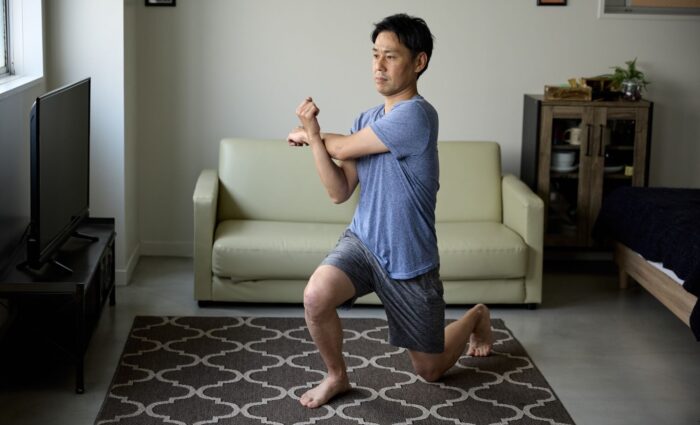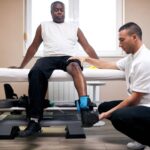When you’re recovering from an injury or surgery or managing everyday stiffness, doing physical therapy exercises at home can make a big difference. These exercises improve flexibility, restore mobility, and strengthen weak muscles. With consistent effort, you can move more comfortably and return to your normal daily activities faster.
Home-based physical therapy isn’t just convenient; it’s also empowering. You can maintain progress between sessions with your therapist and reduce the need for frequent clinic visits. At Rego Park Diagnostic & Treatment Center, our licensed physical therapists design safe, evidence-based routines tailored to your recovery goals and lifestyle. Whether you’re managing shoulder tension, back pain, or post-surgery mobility challenges, our team helps you build strength and confidence.
Understanding Physical Therapy at Home
Physical therapy at home refers to doing guided rehabilitation exercises outside of a clinic setting, usually after learning them from a licensed therapist. It’s ideal for people recovering from injury, surgery, or chronic pain who want to stay active without overexerting themselves. The main benefits of home physical therapy include:
- Convenience and flexibility: You can do it at your own pace, on your schedule.
- Improved recovery: Consistency between therapy sessions accelerates healing.
- Better overall well-being: Regular movement boosts circulation, reduces stiffness, and promotes long-term joint health.
If you’re beginning a new exercise plan, consult your physical therapist before starting. They can help you adjust each movement based on your body type, strength level, and stage of recovery. This is especially important if you’re dealing with previous injuries or have recently had surgery.
Preparing for Home Physical Therapy
Before starting your daily routine, make sure your space is safe and comfortable. You don’t need a gym, just a few essentials and a bit of open space.
Here’s a quick guide to setting up your home environment:
| Equipment | Household Substitute | Purpose |
| Resistance band | Towel or scarf | Stretching and mobility |
| Small dumbbell | Water bottle | Strengthening exercises |
| Yoga mat | Carpeted area | Comfort and stability |
| Chair | Any sturdy seat | Support and balance |
Start by warming up. Simple movements like shoulder rolls, ankle circles, or neck tilts can prepare your joints and muscles for exercise. Always wear comfortable clothing and maintain good posture during every movement to prevent strain.
Simple Physical Therapy Exercises You Can Do at Home
Doing a few minutes of guided physical therapy exercises at home each day can significantly improve your flexibility and strength. At Rego Park Diagnostic & Treatment Center, our therapists recommend these simple routines you can safely perform between sessions. Below are easy exercises categorized by purpose.
Stretching Exercises for Mobility
Stretching helps reduce muscle tension, increase flexibility, and improve blood flow. It’s especially useful if you spend long hours sitting or recovering from an injury. These gentle physical therapy exercises at home target the neck, shoulders, and spine to restore mobility and relieve stiffness.
Sit upright for a neck tilt and slowly move your head toward your right shoulder, holding for 10 seconds before switching sides. Then, roll your shoulders backward and forward ten times to release tightness. Finally, try a seated spinal twist by crossing your right leg over your left and gently turning your torso. These movements loosen tight muscles, improve posture, and make daily activities more comfortable.
Strengthening Exercises for Stability
Building strength helps protect your joints and prevent future injury. You don’t need equipment since your body weight provides enough resistance. These physical therapy exercises at home strengthen key muscles and improve stability, making movement easier and safer.
Stand an arm’s length from a wall for wall push-ups and lower your body slowly by bending your elbows. Lie on your back for the bridge pose, lift your hips toward the ceiling, and squeeze your glutes and core. Then, perform mini squats by bending your knees slightly and keeping your knees behind your toes. Focus on form, maintain proper alignment, and move at a controlled pace for the best results.
Balance and Core Exercises
Good balance is crucial for mobility, especially for seniors or patients recovering from surgery. A strong core supports your back and pelvis, reducing tension and improving posture. These physical therapy exercises at home build coordination and stability to help prevent falls and support recovery.
Hold a wall or chair for a single-leg stand, lifting one foot and balancing for 10–15 seconds before switching legs. Sit upright for a seated leg raise, tightening your thigh muscles and lifting one leg straight before repeating with the opposite leg. Finally, try the bird-dog pose by extending your right arm and left leg, then switch sides. Regular practice enhances body awareness, coordination, and confidence in movement.
Lower and Upper Body Mobility Routines
These exercises improve the range of motion in major joints like the knees, hips, and shoulders. They help ease stiffness from inactivity or mild arthritis while supporting smoother movement. Performing these physical therapy exercises at home strengthens joints and maintains flexibility for daily activities.
Lie on your back for heel slides, moving one heel toward your buttocks before extending the leg straight and switching sides. Sit or stand upright for a shoulder blade squeeze, pulling your shoulder blades together and holding for five seconds. Then, try hip extensions by standing behind a chair and lifting one leg straight back without arching your lower back. Each movement should feel controlled and comfortable; avoid jerking or pushing through pain.
Pain-Specific Exercise Guides
Different parts of the body may require specialized care. Below are examples of how to adapt your routine depending on your symptoms.
For Lower Back Pain
Perform gentle pelvic tilts and knee-to-chest stretches to relieve lower back pain and improve flexibility. Lie on your back with knees bent, feet flat, and belly pulled in for the pelvic tilt. Press your lower back against the floor, hold for five seconds, then relax. Next, bring one knee toward your chest, hold it gently with both hands, and switch sides. Repeat each exercise five times for the best results.
For Shoulder Pain
Ease stiffness and restore shoulder mobility with slow, controlled movements. Lean forward for a pendulum swing, resting one hand on a table for support while your other arm makes small circles. Then, try wall slides by standing facing a wall with your forearms flat and sliding your arms upward slowly before returning to the starting position. Repeat several times to improve shoulder flexibility and reduce tension.
For Knee Pain
Focus on strengthening surrounding muscles to reduce stress on joints and support stability. Use a sturdy platform for step-ups, stepping up with one leg, bringing the other leg up, then stepping down carefully. Next, perform a hamstring stretch by sitting on a chair’s edge, extending one leg straight, and reaching toward your toes. Hold for 10 seconds, switch sides, and repeat to alleviate pain, improve joint function, and promote balance during recovery.
Safety Tips and Common Mistakes to Avoid
Even gentle exercises can cause strain if done incorrectly. Always listen to your body and stop if you feel sharp or sudden pain.
Here are key safety reminders:
- Don’t hold your breath; steady breathing supports muscle function.
- Avoid locking your knees or elbows during stretches.
- Keep movements slow and controlled; never force a motion.
- If swelling, numbness, or increased pain occur, consult your therapist immediately.
Your safety matters more than the number of repetitions. Quality movement leads to better long-term results.
How Often Should You Do Physical Therapy Exercises at Home?
Consistency matters more than intensity. For most patients, doing physical therapy exercises three to five times per week provides steady improvement. Each session should last 15–30 minutes, depending on your comfort and fitness level.
Monitor your progress weekly, notice improvements in flexibility, balance, or reduced pain. If you experience setbacks, your therapist can adjust your plan. The goal is sustainable recovery, not exhaustion.
Conclusion
Physical therapy exercises at home are an effective way to manage pain, strengthen muscles, and support recovery. They work best when guided by a professional who ensures proper form and safety. By committing to a consistent routine, you can restore mobility, reduce discomfort, and enhance your overall well-being.
At Rego Park Diagnostic & Treatment Center, our dedicated physical therapists design personalized programs that fit your needs and recovery stage. Whether you’re healing from surgery or managing chronic pain, we’re here to help you move better, live stronger, and feel your best. Contact us today to schedule a physical therapy consultation or learn more about our comprehensive rehabilitation services.
FAQs
How to learn physical therapy exercises at home?
You can learn physical therapy exercises at home by following guidance from a licensed physical therapist or reputable medical sources. Therapists can demonstrate proper form, adjust movements for your condition, and create a safe routine. Watching verified tutorial videos and starting with simple stretches also helps build confidence and consistency.
Can I do physical therapy at home by myself?
Yes, you can do physical therapy at home by yourself once a therapist has shown you the correct techniques. It’s important to follow their instructions closely to prevent strain or injury. If you feel pain or discomfort, stop the exercise and consult your therapist before continuing.
Is it okay to do PT exercises every day?
It’s generally okay to do PT exercises every day if your therapist recommends it. Daily routines can help improve flexibility, strength, and recovery speed. However, rest days may be necessary depending on your condition and how your body responds.
What are 5 muscular strength exercises?
Five muscular strength exercises commonly used in physical therapy include wall push-ups, bridges, mini squats, step-ups, and hip extensions. These movements strengthen key muscle groups that support joints and improve stability. Performing them consistently can enhance balance, posture, and overall mobility.




